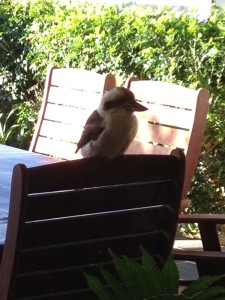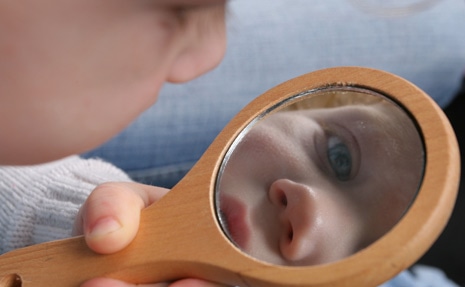âI value my garden more for being full of blackbirds than of cherries, and very frankly give them fruit for their songs.â Joseph Addison, essayist and poet (1672-1719)
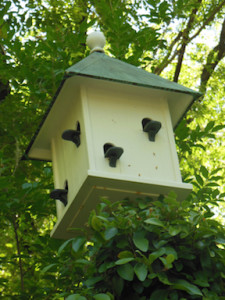
Are you attracting birds to your backyard? In the past few months, I have received numerous emails and calls from readers literally around the world asking questions about our flying friends. Many people have indicated that the bird population has increased in their landscaping, with some gardeners enjoying first time visitors.
Robins, sparrows, hummingbirds, crows, red tailed hawks, quail, mourning doves, jays, owls, chickadees, wrens, bushtits, mockingbirds, thrashers, robins, yellow warblers, finches, larks, wrens, orioles, blackbirds, tanagers, and many other species are calling Lamorinda home.
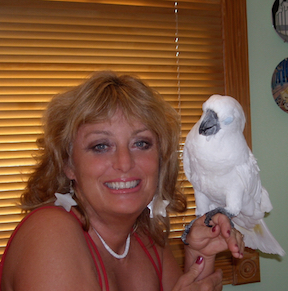
This past week I adopted a one winged cockatiel named Spunky. He and I immediately bonded as he spawned the impetus to write about the benefits of birds. Â Although Iâm a novice at identifying many of these wonderful creatures, birds have always fascinated and entertained me as Iâve watched quail with their newly hatched covey convening on my lawn, or the robins annually lay eggs in the wreath on my back door. This year the airspace around my home is particularly jammed with crows cawing. I thought I was experiencing a remake of âThe Birdsâ recently when a convention of turkey vultures and crows assembled on my rooftop. I snapped a photo of two before jumping into my car for safety as twenty other buzzards landed.
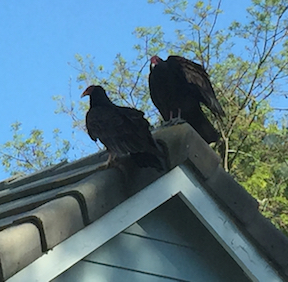
How long have birds been on the planet? In 1859 Bavaria fossils were found dating to 140 million years ago that suggested that modern birds evolved from a feathered ancestor, Archaeopteryx, similar to a dinosaur. The size of a crow, Archaeopteryx is the probable ancestor of over 9,000 species of birds.
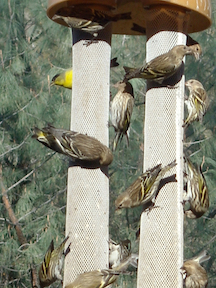
The appeal of birds in our backyards is numerous. While watching their antics and enjoying their beautiful plumage as well as their melodious song is intriguing, the grand dividend for gardeners is their free assistance as garden helpers. Birds are constantly turning over leaves, scratching in mulch, or flitting from bush to tree finding their meal of insects we never see. Birds such as flycatchers and swallows decimate flying pests. Seed-eating birds will glean 95% of the weed seed that grows every season. Â When we welcome birds to our backyards, we are creating a home landscape that will naturally ward off diseases and pests. Bacteria and spores struggle to survive as our gardens become more organic creating a natural balance between pests and plants.
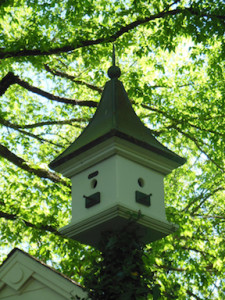
Here are ways to maintain flocks flying as your personal aerial garden rescue crew.
1. WATER: A water feature is a magnet for birds, especially in the hot summer months when water is scarce. Add birdbaths, ponds, and fountains for them to bathe, drink, and even forage. Birds can hear the sound of running water from great distances.
2. SHELTER: Birds need to be protected from the whims of Mother Nature. Many birds love brush piles that offer cover. They search for nest building areas and will find your birdhouses, especially those placed in sites that mimic natural surroundings. Some birds, like wrens, will reside nightly in a birdhouse to keep warm and safe. Install roosting boxes and shelves. Â If you already have birdhouse, keep them clean. As Miguel de Cervantes wrote âNever look for this yearâs birds in last yearâs nests.â
3. FOOD: Birdfeeders offer a birds-eye view of their acrobatic displays. Plus, supplementing their meals could be the difference between life and death. Include seed, suet, fruit, nuts, and nectar for the hummingbirds. In the winter, make sure to continue feeding. If you plan to stop feeding your birds, slowly wean them so as not to cut off their food supply.
4. PLANTS: Plant evergreens, vines, shrubs, annuals, and perennials. Birds especially enjoy fruit bearing trees like peach, plum, apricot, and elderberry as well as seed bearing plants like Blackeyed Susan, cosmos, and sunflowers. Hummingbirds are attracted to red, deep-throated flowers with nectar. Include scarlet trumpet vine in your yard. Native species including mustard, wild pea, poppy, shooting star, milkweed, larkspur, lupine, columbine, anemone, bleeding heart, and verbena will draw hummingbirds, butterflies, and seed and insect eating birds to your backyard.
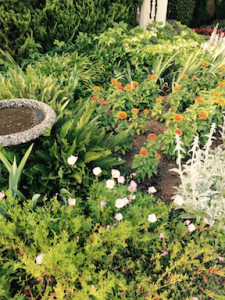
Take care of your birds and they will take care of your garden. Life is for the birds!
Cynthia Brianâs Mid Month Garden Tips
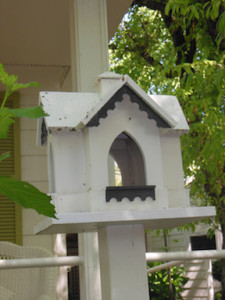
GRILL your fresh-picked eggplant, corn, watermelon, and peppers on the barbecue. Brush with olive oil and garlic, sprinkle with salt and sage or cilantro.
PICK pears and Asian pears. Slice up into salads or eat then fresh off the tree.
DIVIDE bearded iris. When iris rhizomes are crowded, they will not bloom. Use a sharp shovel to slice through the rhizomes, then re-plant in other areas or share with friends. Even small pieces will grow into plants.
SUCCESSION plant arugula, lettuce, carrots, beans, and beets for crops that will continue to feed you through fall.
ENJOY the birds. They are favorite friends of our landscapes providing entertainment, pest control, and nature nurture.
Happy Gardening and Happy Growing!
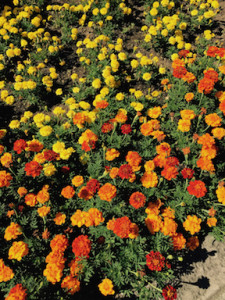
⢠Read more with photos
⢠Read August Garden Guide
©2015
Cynthia Brian
The Goddess Gardener
Starstyle® Productions, llc
Cynthia@GoddessGardener.com
www.GoddessGardener.com
925-377-STAR
I am available as a speaker, designer, and consultant.
Cynthia Brian is a New York Times best selling author, speaker, coach, and host of the radio show, StarStyle®-Be the Star You Are!® broadcasting live every Wednesday from 4-5pm PT on the Voice America Network.. She also is the creator and producer of Express Yourself!⢠Teen Radio and Executive Director of Be the Star You Are!® 501c3 charity.

